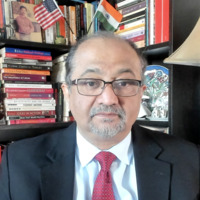
Sanghita Sen
University of St Andrews, School of Philosophical, Anthropological and Film Studies, Honorary Research Fellow in Film Studies
I am a practice-based film researcher and documentary filmmaker. After my Master's in English, I went on to specialise in Linguistics and semiotics. I did my M.Phil in Linguitics & Phonetics and first Ph.D in comparative literature. I received my second PhD from the University of St Andrews for my thesis on Indian political cinema of the 1970s with reference to films of Ritwik Ghatak, Mrinal Sen, and Satyajit Ray. Currently, I am working on my feature documentary project.
My research interest includes Marxism, Third Cinema, Indian cinema, tricontinentalism, decolonisation, Gender and Cultural Studies, and practice-based research.
I curate film programmes and do subtitling for Bengali and Hindi language films. I am also a knitter.
My research interest includes Marxism, Third Cinema, Indian cinema, tricontinentalism, decolonisation, Gender and Cultural Studies, and practice-based research.
I curate film programmes and do subtitling for Bengali and Hindi language films. I am also a knitter.
less
Related Authors
Muqtedar Khan
University of Delaware
Iain Robert Smith
King's College London
Ahmar Mahboob
The University of Sydney
Benjamin Isakhan
Deakin University
Andrea Peto
Central European University
Jenny Chamarette
The Open University
Armando Marques-Guedes
UNL - New University of Lisbon
Giulia Sissa
Ucla
David Martin-Jones
University of Glasgow
Johnni Langer
UFPB - Universidade Federal da Paraíba
InterestsView All (10)










Uploads
Books by Sanghita Sen
propose to explore the geo-political and eco-sociological logical spatiality of the Chambal, through Deleuze and Guattari’s theorization of a nomad space, and Walter Mignolo’s agenda of “location” of enunciation, thus de-privileging the human, using the three texts above as case studies. The Chambal thereafter becomes an enabling space of border thinking through and beyond coloniality of power, as the women-dacoits perform embodied counter-narratives here. This counter-narrative dislocates a processual culture of a competitive patriarchal assemblage of sympathetic inclusion by the media, the condescending government institutions, and popular culture. The Chambal valley and its nomad
occupants become a perfect example of a Deleuzean War Machine.
industry churning out popular films, one can easily find reflections of socio-cultural practices entrenched in the nation’s deep-rooted patriarchal Brahmanical1 foundations and concomitant toxic misogyny. It took a long time for Indian women to access popular film industries. In early Indian cinema, there were only two women who attained prominence in Bombay cinema: Fatma Begum (1892–1983) and Devika Rani (1908–1994). More recently, however, women producers, directors, scriptwriters, editors and set and costume designers are gradually making headway in India’s Hindi-language filmmaking hub in Mumbai, better known as Bollywood – though they are still underrepresented. While there are notable changes in the equally important regional industries in terms of women’s participation in the process of filmmaking, it is impossible to do justice to this hugely under-researched yet highly significant development in a single article. In this chapter, I therefore discuss the ways in which women travail within, negotiate, modify, manipulate and subvert the popular formats of different genres in films produced specifically in Bollywood. This chapter will begin with an overview of the perception, role and functioning of the Bombay film industry in India. In section two, I analyse films from the 1990s to the first decade of the new millennium directed and written by Honey Irani and Tanuja Chandra. I will examine how they carved out a creative tradition that has had enormous impact on postmillennial directors of all genders. The focus of the final section is on the wide range of genres in which the post-millennial women directors of Bollywood work.
Papers by Sanghita Sen
propose to explore the geo-political and eco-sociological logical spatiality of the Chambal, through Deleuze and Guattari’s theorization of a nomad space, and Walter Mignolo’s agenda of “location” of enunciation, thus de-privileging the human, using the three texts above as case studies. The Chambal thereafter becomes an enabling space of border thinking through and beyond coloniality of power, as the women-dacoits perform embodied counter-narratives here. This counter-narrative dislocates a processual culture of a competitive patriarchal assemblage of sympathetic inclusion by the media, the condescending government institutions, and popular culture. The Chambal valley and its nomad
occupants become a perfect example of a Deleuzean War Machine.
industry churning out popular films, one can easily find reflections of socio-cultural practices entrenched in the nation’s deep-rooted patriarchal Brahmanical1 foundations and concomitant toxic misogyny. It took a long time for Indian women to access popular film industries. In early Indian cinema, there were only two women who attained prominence in Bombay cinema: Fatma Begum (1892–1983) and Devika Rani (1908–1994). More recently, however, women producers, directors, scriptwriters, editors and set and costume designers are gradually making headway in India’s Hindi-language filmmaking hub in Mumbai, better known as Bollywood – though they are still underrepresented. While there are notable changes in the equally important regional industries in terms of women’s participation in the process of filmmaking, it is impossible to do justice to this hugely under-researched yet highly significant development in a single article. In this chapter, I therefore discuss the ways in which women travail within, negotiate, modify, manipulate and subvert the popular formats of different genres in films produced specifically in Bollywood. This chapter will begin with an overview of the perception, role and functioning of the Bombay film industry in India. In section two, I analyse films from the 1990s to the first decade of the new millennium directed and written by Honey Irani and Tanuja Chandra. I will examine how they carved out a creative tradition that has had enormous impact on postmillennial directors of all genders. The focus of the final section is on the wide range of genres in which the post-millennial women directors of Bollywood work.
Indian social structure and an oppressive Indian state that functioned still under colonial administrative regulation, as caretaker of interests of the powerful classes. In this article, I argue that the Naxal movement helped Indian cinema to map out the history and internal architecture of political dissent in post-independence India and construct a counter-nationalist discourse. The paper aims to evaluate how the Naxal Movement serves as a resource to represent the politics of dissent in India in the 1970s in parallel cinema and as a critique of the neo-liberal policies of the Indian State in the postmillennial Bollywood films.
It aims to analyse selected films that deal with the Naxal/Maoist movements in India as a counter historiography.
I found the argument extremely fascinating. If one looks closely into the literary traditions, mythology, and folklores of the world, one can see that there exists striking similarity in ideas, concepts, themes, and even narrative treatment across culture.
For example, Sita’s abduction by Ravana bringing about a great war between two kingdoms leading to the complete destruction of Lanka in the Ramayana is quite like Helen’s abduction of/elopement with Paris leading to the complete destruction of Troy in The Iliad.
Cinema as an expressive art form is no different. Like there are limited number of phonemes in the system of human languages, like there are limited number of mythemes in the world mythology, there are limited number of essential kernels that forms narratives of films. We can perhaps call them cinemes.
Creative inspiration has always played important role in artistic practices. It is only comparatively recently that the charge of thought theft is being used rather often, both nationally and internationally. Of course, there are innumerable films that are thoughtless remakes of successful film without formal acknowledgment as there are films that inspired filmmakers from a different culture for her/his own project. In this presentation, I’ll briefly talk about the maze of adaptations/remake/and inspired filmmaking as inherent cultural practice in world cinema, in whatever name the gatekeepers decide to call it.
The struggle and the tribulations of the caste, ethnic and religious other is rendered ‘invisible’ not only in the national print media but also in other cultural forms such as films, Tele serials, and advertisements as well. There are innumerable documented cases of mob violence, lynching, shaming, rape, and murder of Dalits that remain absolutely unreported and unrepresented in traditional media. This absence of representation reflects the pre-existing invisibility of the Dalits in a highly casteist hegemonic Brahminical Indian society. Social Media are increasingly being used by Dalit activist groups not only to create visibility for their ideological argument, and solidarity for their struggle and political demands but also to counter concerted efforts from the state ideological apparatuses working through the corporate media and the creative industries rendering their position and movements ‘invisible’. In this paper I will document how social media are being utilised as an archive for the visible evidence of counter-culture resistance against the politics of (in)visibility of the Dalit and ethnic other within a culture whose norms for mediation of ‘visibility’ are determined by deep-rooted practices of social discrimination that the mainstream Indian corporate media and culture industry perfectly replicates.